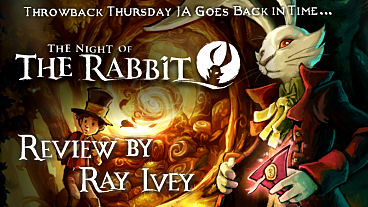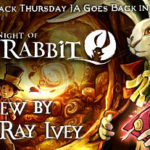
Throwback Thursday: The Night of the Rabbit Review
If you’re longing for a traditional third-person point-and-click game with lots of puzzles, characters, story and extras, you cant go wrong with this one!
 





Release Date: May 28, 2013
Platform: Windows, Macintosh (Reviewed on Windows)
Note: This review was originally published July 19, 2013
You’re a twelve-year old boy. There are only two days left of your summer vacation. Nothing particularly interesting has happened all summer. It’s difficult not to feel a certain pressure to find a way to squeeze a bit of adventure out of the last crumbs of your vacation. This is the situation young Jerry Hazelnut finds himself in at the opening of Daedalic Entertainment’s ambitious new graphic adventure The Night of the Rabbit.
Jerry’s a normal kid. He loves comic books and astronomy, and he’d love to be a magician. He has a nice Mom and lives in an idyllic house seemingly on the edge of a lush forest. However, reality – like the impending threat of the new school year – hems in Jerry’s bucolic world. He actually lives just outside a teeming modern city, with its accompanying noises, environmental threats and overall grey inhumanness.
After a mysterious prologue in which a disoriented humanoid rabbit confers with a strange-looking wood-sprite, Jerry finds himself standing just outside his house, pondering his next move. While the task he gets from his mother – go gather her some wild blackberries – doesn’t sound exactly adventurous, at least it comes with the tantalizing reward of Mom’s blackberry pie for dessert.
Before he can take off in search of the berries, Jerry is startled by a strange, triangular letter that appears to fly into his family’s mailbox. It contains a strange recipe for a summon of some kind. Well, that’s a bit more like it!
While not neglecting his mother’s request for pie ingredients, Jerry sets about finding the ingredients for what seems to be a magic spell. This is where the game begins in earnest.
GAMEPLAY
The Night of the Rabbit is a traditional third-person point-and-click adventure. You control Jerry throughout the game, and you explore the environments as in traditional games of this type.
Very soon our young hero is transported to an alternative version of his familiar forest, a town of sentient animals called Mousewood. Mousewood is in crisis, and guess who is the only person who can help them avoid disaster?
The game gets many things right. First of all, the environments have a lush, beautiful hand-painted look, making them a pleasure to spend time in and explore. The palette is earthy, but not without some bright colors.
Within these lovely environments, you help Jerry talk to the citizens of Mousewood and interact with the objects in it. There is a lot of dialog in the game. Since there’s so much story to be told, I counsel patience with this all this talking. It’s mostly good stuff, as the many characters have fun things to do and say.
Early on in the game Jerry is given a magic coin which serves, among other things, as an easy way to make sure you’re not missing any hotspots in the environment. Click on the coin (or, even easier, on the spacebar), and all interactive bits on the screen glow. This type of friendly interface is vital when there are so many different screens, and so many different things to interact with and collect.
As you interact with the story and its characters, a notebook will automatically update, which you can check any time in the interface. This is vital, because the puzzles in The Night of the Rabbit, while of the traditional inventory-based kind, require patience and a good memory. Often a character will mention something about him/herself (“I’m very advanced!”) which will make sense when you find an ad for music lessons (“Looking for only advanced students!”)
The story threads in the game are wide-reaching and have a lot of depth, so it can be easy to forget a detail like the one listed above, making it frustrating to complete puzzles. This is a game in which you might even want to make your own notes.
Even if you have a great memory and an eye (and ear) for detail, there may be times in the game when the puzzles’ solutions elude you. Sometimes it’s simply because the solution just doesn’t seem that logical. (Really? Placing a rake on this spot will trap the Leprechaun?) Another reason is that the game world gets bigger and bigger as you progress through it. There were times when I would think, “Okay… now on which of the game’s forty screens am I going to find this thing I need to find?”
It helps that about halfway through the game, you gain access to a sort of rudimentary fast travel system, involving a friend you make, a frog mailman named Plato. Still, the sheer size of the game world can sometimes be intimidating.
That being said, I should add that the game world gradually opens up as you solve puzzles and accomplish story progression, and that process is quite satisfying and fun.
The game’s story is epic, and at times, epically strange. It’s got a plot worthy of a classic Japanese RPG in terms of operatic complexity. At the story’s heart, though, Jerry is on a mission as a magician’s apprentice. He needs to open a series of magic portals and learn a series of magic spells. The portals lead to environments that make the world of the game even more expansive (Japan and Ireland, for example). The magic spells give you new tools that you need to solve the challenges that face you in Mousewood.
As with many fantasy-themed tales, the story gets weirder and stranger as you get closer to the end. By the game’s final act, it’s downright odd. But the game gets away with it, because the designers embrace the weirdness by modifying the environments, the colors, and even the music to fit the strange stuff that’s happening.
In addition to the game’s lengthy, rich story, there are other things to occupy your time in Mousewood. There’s a collection game (dewdrops), a card game (basically a variant of Go Fish) and even a series of achievements. The achievements vary widely and have their own interface. If you find yourself having a wonderful time in the game’s fantasy world and you don’t want to rush the experience, there’s quite a lot to do.
FINAL THOUGHTS
The Night of the Rabbit is another strong entry in Daedalic’s collection of traditional adventure games. If you’re longing for a traditional third-person point-and-click game with lots of puzzles, characters, story and extras, you can’t go wrong with it!
|
Grade: A
+ Great traditional 3rd-person point & click.
+ Game’s story is epic.
|
 |
System Requirements (PC)
- 2.5 GHz Single-Core-Processor or 2 GHz Dual Core Processor
- 2GB RAM (2.5 if Windows Vista/7/8 OS)
- OpenGL 2.0 compatible graphics board with 256MB RAM (shared memory not recommended)
- DirectX9.0c compatible soundboard
- 6 GB HD space
- DVD drive
- Mouse
System Requirements (Mac)
- OS: MacOS X Lion (10.7)
- 2 GHZ (Dual Core) Intel
- 2 GB RAM
- 6 GB HD space

Leave a Reply